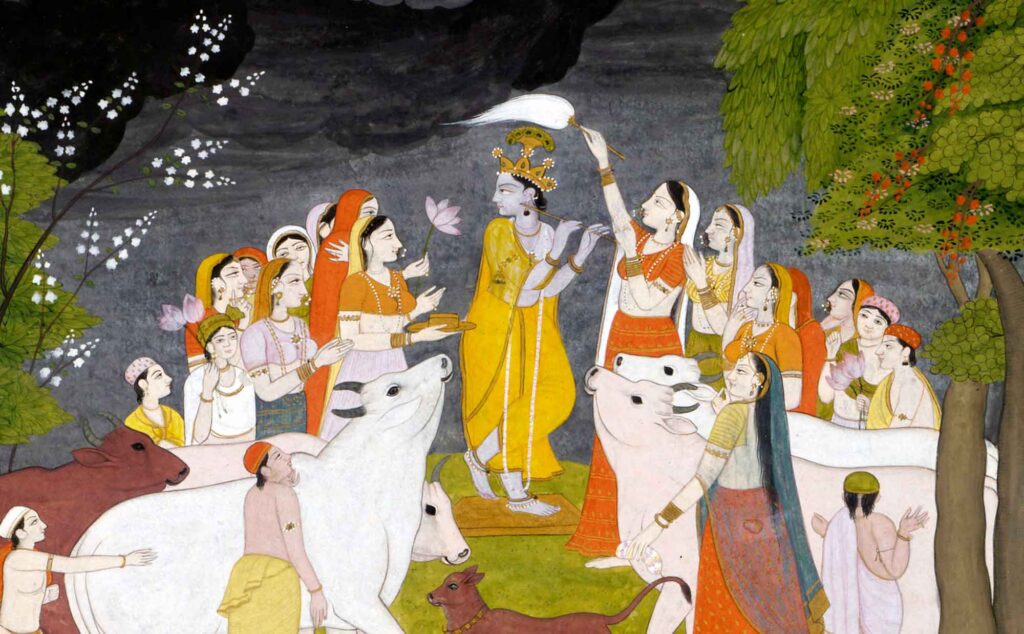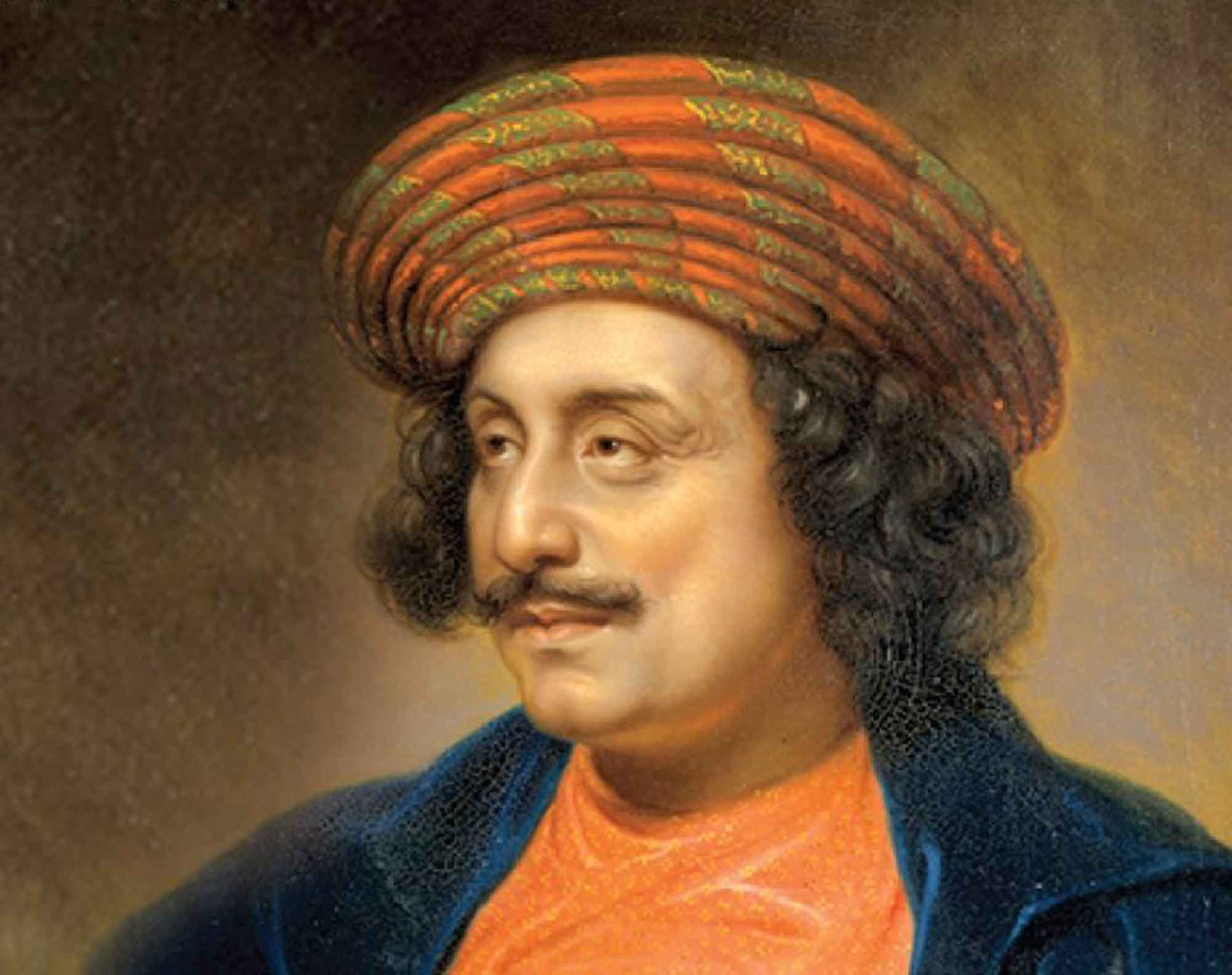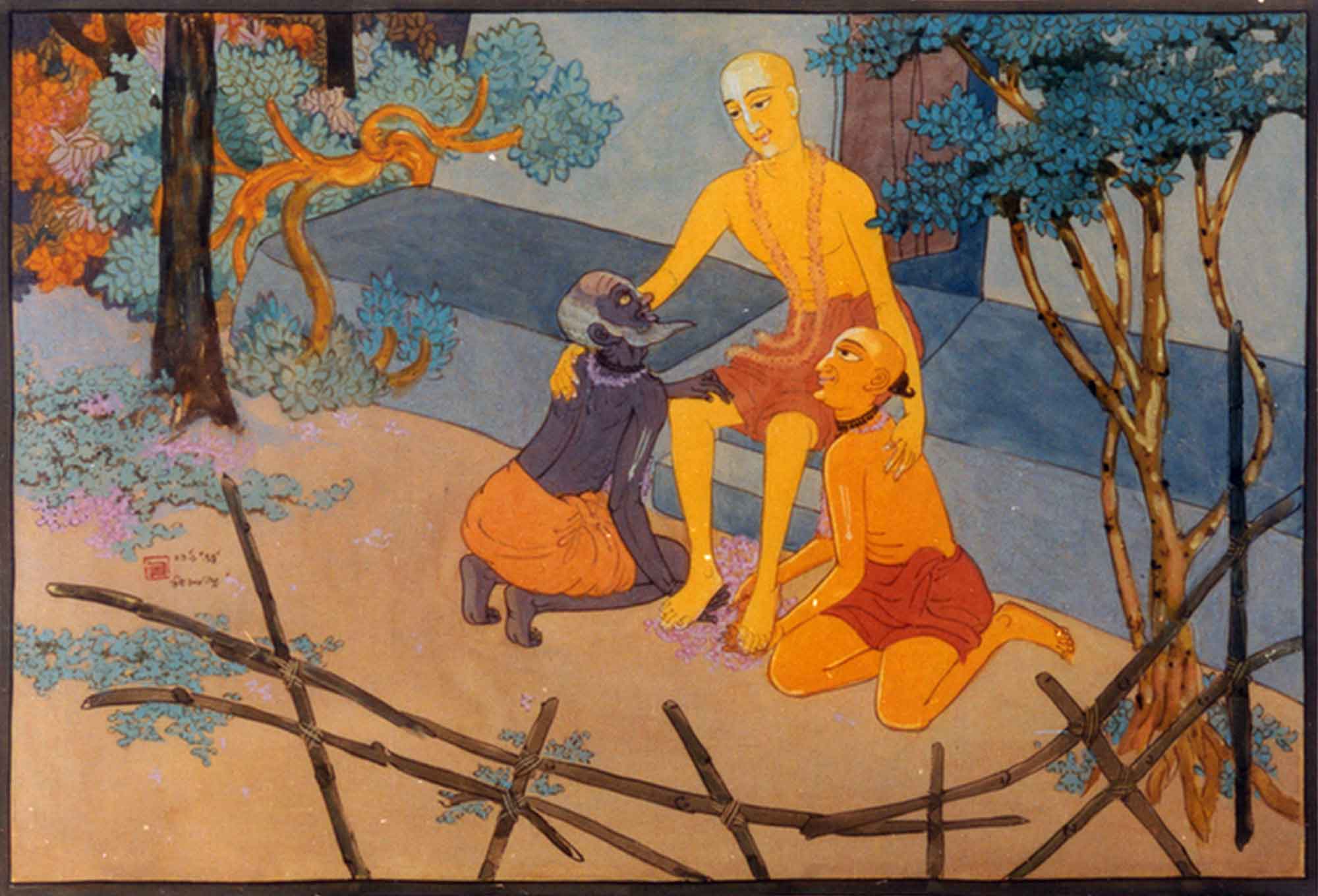Overview
‘Śrī Śrī Navadvīpa Dhāma’ was first published in Śrī Viṣṇupriyā Patrikā, Vol.2 issue 5 in 1891. This article was written just after Bhaktivinoda Ṭhākura had published Śrī Navadvīpa Dhāma Māhātmya, and here, we find the Ṭhākura giving evidence for Māyāpura as the birthplace of Śrī Caitanya Mahāprabhu.
(translated by Swami B.V. Giri)
Only Vaiṣṇavas believe that Śrī Navadvīpa Dhāma is the manifestation of Śrī Vṛndāvana Dhāma. There is no doubt that the primary śāstra and all the mahājanas agree with this belief. The Vaiṣṇava śāstra describes many glories of Śrī Navadvīpa Dhāma. The book Śrī Navadvīpa Dhāma Māhātmya, which has been published, contains irrefutable evidence from many śāstra. Readers will know this from reading that book. Now we will discuss some of these topics that are pleasing to our Vaiṣṇava readers.
Countless men and women from the different states of Bengal such as Śrīhaṭṭa, Maymansingha, Dākā, Chaṭogrāma, Tripurā, Rājasāhī, Raṅgapura, Pūrṇiyā, Māladah, Mūrśidābād, Barddhmān, Baṅkuḍā, Birbhūma, Medinīpura, etc. as well as Orissa, and the Western and Southern states come to Śrī Navadvīpa. When they leave the house, in their minds they hope that we will go to Śrī Navadvīpa and take darśana of the janma-sthāna and līlā-sthāna of Śrī Śrī Mahāprabhu and satisfy their two eyes. But when they come to the banks of the Gaṅgā at Navadvīpa and ask, “O dhāma-vāsīs, show us the janma-sthāna and līlā-sthāna of Mahāprabhu” then the dhāma-vāsīs reply that all those places are now in the middle of the Gaṅgā and are destroyed. It is impossible to describe the sadness of those devotees. They think, “Oh! Our birth has been in vain. We did not see the Lord’s līlā-sthāna!” At the place which is currently being referred to as Navadvīpa, some persons have specified imaginary places, exhibiting them to be līlā-sthānas. Some of the devotees are not happy.
Then have all the līlā-sthānas of Śrī Śrī Mahāprabhu completely disappeared? Will the jīvas of the age of Kali be completely deprived of the happiness of visiting those places? The answer is no. All the līlā-sthānas of Mahāprabhu are manifest. The change of the course of Gaṅgā Devī and Vāg Devī has changed the size of those places, but after carefully searching through authentic texts such as Śrī Caitanya-Bhāgavata etc., we have decided to publish this gradually in order to increase the happiness of our Lord. First of all, we have pointed out the place of Mahāprabhu’s village.
All those who have discussed the bhakti-śāstra know that the measurement of Śrī Navadvīpa-maṇḍala is sixteen krośas (approx.32 miles). Just like Śrī Vṛndāvana, Śrī Navadvīpa is a round, eight-petalled lotus. Each petal is an island, and the centre of the lotus is also an island. Ones should think of the centre as an island, and the eight petals around it are eight islands. The name of the island in the centre is Antardvīpa. We will name the eight petals starting from the northern petal. Sīmantadvīpa, Godrumadvīpa, Madhyadvīpa, Koladvīpa, Ṛtudvīpa, Jahnidvūpa, Modadrumadvīpa, and Rudradvīpa. The area that covers these nine islands is altogether known as Śrī Navadvīpa. We will first describe Antardvīpa. The name of the place in the middle of Antardvīpa is Śrī Māyāpura. In the middle of the village of Māyāpura is the mahā-yogapīṭha. The triple-flowing Gaṅgā Devī flows through these nine islands, and her name is Bhāgīrathī. Mandākinī is the name of the river which was formerly strong, which flows along the north-eastern side of Navadvīpa. Jāhnavī is the name of the river which was formerly strong, along the south-western edge of Navadvīpa. Therefore Śrī Kavi Karṇapura writes that Navadvīpa Dhāma is surrounded by Śrī Gaṅgā Devī’s and this is also written in Tantra. The name of the river Khaḍi which joins the Bhāgīrathī at Svarūpa-gañj near Goyāḍi is actually called Vāg Devī or the Jalaṅgī. Long ago, the Vāg Devī flowed near the village of Hariśpura and after mixing with the Mandākinī, it flowed near to Devapallī, then touching the city known as Bhālukā, this river mixed with the Bhāgīrathī near the village of Goyālāpāḍā. When the Mandākinī portion of Gaṅgā Devī dried up, then Vāg Devī reached Bhāgīrathī, while flowing on one side of Māyāpura. At the time when Vāg Devī reached Bhāgīrathī, many parts of Śrī Māyāpura were almost destroyed. At that time, the brāhmaṇa paṇḍitas there became homeless and took Śrī Prauḍhā Māyā and Vṛddha Śiva to the village of Kuliyā, and established a new village there. That new village is the present day city of Navadvīpa. There are no līlā-sthānas of Mahāprabhu in this new village. This place is the shore of Vṛndāvana within Navadvīpa. On the map that we have given in the book Śrī Navadvīpa Dhāma Māhātmya, it shows that there is a cakra in the middle. The entire piece of land in this cakra is Antardvīpa, and only two tiny slivers of land extend to the other side of the Bhāgīrathī.
We have already said that the land between Śrī Māyāpura and Antardvīpa is special. The village of Māyāpura was the home of the brāhmaṇa community during the time of Śrī Śrī Mahāprabhu. By the flow of Vāg Devī, it has almost been devastated. Only one part of Māyāpura has a settlement. On this side, in the southern corner is Ballāl Dighi. Devout (and therefore thoughtful) persons go there to search for the birthplace of Mahāprabhu. A famous Vaiṣṇava, Gaṅgā-Govinda Singh Mahāśaya was appointed to the post of dewān (chief minister) and was somewhat successful. Without seeing Gaṅgā Devī near Ballāl Dighi, based upon a mistake, he founded the city called Śrī Rāmacandrapura in the western part of Gaṅgānagara, where he built the house of Śrī Jagannātha Miśra. He could not determine where Śrī Gaṅgā Devī was at the time of Śrī Śrī Mahāprabhu. That is why his appointed place was destroyed in the middle of Gaṅgā not long after. We have done a lot of research and have been able to determine where the bank of the Gaṅgā was at that time due to some confidential indication. There is still a long stream called Śiva Ḍobā flowing in the southern part of Māyāpura where a forest full of dry grass can be seen. Standing on the banks of this stream and looking at Gaṅgānagara, it is seen that the flow of the river goes towards Gaṅgānagara through Māyāpura. O devotees, that Śiva Ḍobā should be considered as the place of an old Śiva temple. Śrī Jagannātha Miśra’s residence is close to its shore. Now let us consider the geography obtained in the description of the first kīrtana by Śrī Vṛndāvana Dāsa Ṭhākura:
gaṅgā-tīre tīre patha āche nadīyāya
āge sei pathe nāci yāya gaura-rāya
āpanāra ghāṭe āge bahu nṛtya kari
tabe mādhāyera ghāṭe’ gelā gaurahari
bārakoṇā-ghaṭe nāgariyā-ghāṭe giyā
gaṅgāra-nagara diyā gelā simuliyā
(“First, Gaura Rāya danced along the path on the banks of the Gaṅgā in Nadīyā. After dancing for a long time at His own ghāṭa, Gaurahari then went to Mādhāi’s ghāṭa. After going to Bārakoṇā Ghāṭa and Nāgariyā Ghāṭa, He then went through Gaṅgānagara to Simuliyā.” – Caitanya-bhāgavata, Madhya-khaṇḍa 23.298-300)
We will not say exactly where Śrī Śrī Mahāprabhu’s house and Mādhāi’s ghāta is – at this point we are compelled to keep everything we know about it as a secret. Now it is mentioned that the places Bārakoṇā Ghāṭa and Nāgariyā Ghāṭa are not far from the shore. The Nāgariyā Ghāṭa was near to the main bazaar in East Nadīyā, and that market was a little west of Ballāl Dighi. With all this in mind, there is no doubt that devotees will find Śrī Śrī Māyāpura and Mahāprabhu’s janma–sthāna and līlā-sthānas. The Vaiṣṇavas that own the Cāravāsī Ākhaḍā of Kuliyā do not care to know this. That is why the devotees are so unlucky. Just like the paṇḍas of Śrī Puruṣottama-kṣetra and the Vraja-vāsīs of Vraja-dhāma, if the people at the Cāravāsī Ākhaḍā of Kuliyā has been more careful, they could have easily shown the Lord’s līlā-sthānas to the devotee pilgrims that are attracted to them. We request them to immediately look at the book Śrī Navadvīpa Dhāma Māhātmya carefully and try to show all the līlā-sthānas to the pilgrims. In order to help them, we have given specific directions to the līlā-sthānas.
There is a rule that Navadvīpa parikramā should start from Śrī Māyāpura. At present, there is no place in Māyāpura where pilgrims can spend the night. It is the duty of the wealthy householder Vaiṣṇavas to immediately build a large pillar at the birthplace of Śrī Śrī Mahāprabhu and set up two to four shops there before the parikramā. In this way, eventually a melā (fair) will be established there. It is important that a large flag and a light be placed on the pillar indicating the direction of Jagannātha Miśra’s house. The place at present is in a lower position, therefore a permanent building cannot be constructed. However, in the months of Māgha/Phālguṇa (January/February), it is possible to build a large hut there. There is a wonderful place south of Ballāl Dighi – there, some building could be constructed where the service of the śrī-mūrtis of Śrī Śrī Gaurāṅga, Viṣṇupriyā, Śacī Mātā etc. could be established. Along with that service, the work of protecting the pillar indicating the janma-sthāna, the establishment of a melā during the month of Māgha/Phālguṇa and the construction of residences for pilgrims could proceed smoothly. We have considered that if a fortunate rich gentleman is willing to spend ten thousand rupees, then this work can happen. If anyone wants to know the details concerning this, you can discuss all the issues with us in the office of this magazine. It is not difficult for nirapekṣa-bhaktas (devotees who are neutral) to indicate where in Śrī Māyāpura Śrīvāsāṅgana was, where Candraśekhara Ācārya’s house was, where Murāri Gupta lived, where Jagadiśa and Hiraṇya made offerings to Mahāprabhu, or where Nandanācārya’s house was where Śrī Nityānanda Prabhu came. When the curiosity to know this arises, Śrī Viṣṇupriyā Mātā, who is the dhāma-svarūpinī (embodiment of the dhāma) will effortlessly award revelation. O devotees! Today put away other hopes and thoughts, and endeavour with fervor to discover this lost mahā-tīrtha-sthāna. Your research is not as difficult as that of Bhāskarācārya, Āryabhaṭṭa etc. and the paṇḍitas of astrology in relation to the nature and motion of planets and constellations. When they do research into mundane topics, materialistic scholars are forced to do many difficult tasks such as building material machines. But, O Nityānanda’s madmen! Your position is not of this mundane world. You may think you are doing everything in vain, but once you fall at the lotus feet of Nityānanda Prabhu, you can even pick up the transcendental Śvetadvīpa just as one picks up an āmalakī fruit in his hand. O Gaurāṅga! O Viṣṇupriyā! O Prabhu Nityānanda! O Prabhu Advaita! O Gadādhara! O Śrīvasa! Kindly show me all the places of the transcendental dhāma of the Pañca Tattva! O holy Vaiṣṇavas! Do not delay any longer! Fallen akiñcanas like us are desperate to see the līlā-sthānas of the Lord and the Lord’s associates. When the devotees of Vraja became very anxious to see the līlā-sthānas of Śrī Kṛṣṇa, Śrī Śrī Caitanyadeva, the ocean of mercy, empowered Śrī Sanātana and revealed Śrī Rādhā-kuṇḍa and Śrī Śyāma-kuṇḍa in two rice fields. By the mercy of Sanātana Gosvāmī, everyone now knows the glories of these two holy places. O beloved devotees of Gaurāṅga such as Jagannātha Dāsa, we offer our daṇḍavats at your feet and pray with folded hands that all of you may take the position of Śrī Sanātana Gosvāmī and point out the exact place of Śrī Māyāpura. Now you are our guru. Who else will tell us?
The mahā-tīrtha of Māyāpura, which is another manifestation of Śrī Gokula, is extremely powerful in the age of Kali. Just as there is Paurṇamāsī in Śrī Vṛndāvana, so too in Māyāpura there is Prauḍa Māyā (whom people call Pauḍāmā) who controls everything. Amongst the seven mahā-tīrthas such as Ayodhyā, Mathurā, Māyā etc, Māyā-tīrtha exists in Haridwar in one form, and in a second form it resides in Gauḍa. The influence of Māyā-tīrtha is such that some of the Muslims who currently reside there consider the Lord of our life, Gaurāṇga to be their Lord and take care of Gaurāṅga’s devotees as friends. The Bhāgīrathī is gradually coming closer to the house of Mahāprabhu again by the side of Śrī Gaṅgānagara. It seems that between two to five years it will flow again through Bārakoṇā Ghāṭa, Nāgariyā Ghāṭa, Mādhāi’s Ghāṭa and Mahāprabhu’s Ghāṭa. It is understood that the city of Śrī Mahāprabhu will soon be manifest as before. At this time, those that reawaken the dhāma by pointing out the various places, will be forever remembered in the Vaiṣṇava world and will be regarded as special devotees in the future.
Small villages such as Śrī Gaṅgānagara, Bharadvāja-ṭīlā (Bhārui-nagara) etc. all belong to Antradvīpa. Śrī Gaṅgā Dāsa Paṇḍita’s ṭola (Sanskrit school) is in Śrī Gaṅgānagara. The fallow land in the north-eastern part of Māyāpura has been the same since the time of Śrīnivāsa Ācārya Prabhu. This can be seem in Bhakti-ratnākara. From that place, Śrī Suvarṇa Vihāra can be seen. This land is mentioned in the Tantra as the land of where Brahmā, the creator of the universe, performed austerities. Long ago, in the eastern part of Māyāpura and between Anatardvīpa, there was a small channel coming from Vāg Devī to the Bhāgīrathī. The mouth of that channel is observed at the south-eastern section of Śiva Ḍobā. At that time, there was a temple to Prauḍhā Māyā in the banks of Vāg Devī. After taking bath in this channel of Vāg Devī, students would display their scholarly aptitude in the temple of ‘Prauḍā Māyā’ and accepted academic titles. Vāg Devī’s channel was so small that during nagara-kīrtana with thousands of devotees, Mahāprabhu used to go to Godrumadvīpa without even taking a boat. When the Mandākinī became dry, all the water of from Vāg Devī took refuge in that channel and Māyāpura split apart. Recently, Vāg Devī and the Bhāgīrathī converged at the Triveṇī. We will publish details about the tīrtha of Simantadvīpa in our next article.












